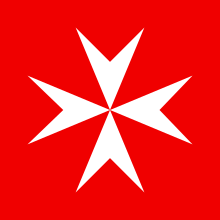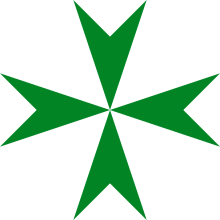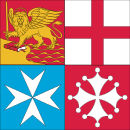Maltese cross: Difference between revisions
Rescuing 1 sources and tagging 0 as dead. #IABot (v1.6.1) (Balon Greyjoy) |
Rescuing 1 sources and tagging 1 as dead. #IABot (v1.6.2) |
||
| Line 139: | Line 139: | ||
Other [[cross (heraldry)|crosses]] with spreading limbs are often mistakenly called "Maltese", especially the [[cross pattée]]. The official symbol of the [[Alpha Tau Omega]] fraternity is the [[cross pattée]], though the organization's founder thought it was a Maltese cross when the organization was formed in 1865. The [[Nestorian cross]] also is very similar to both of these. |
Other [[cross (heraldry)|crosses]] with spreading limbs are often mistakenly called "Maltese", especially the [[cross pattée]]. The official symbol of the [[Alpha Tau Omega]] fraternity is the [[cross pattée]], though the organization's founder thought it was a Maltese cross when the organization was formed in 1865. The [[Nestorian cross]] also is very similar to both of these. |
||
The cross of [[Saint Florian]], [[patron saint]] of [[firefighter]]s, is often confused with the Maltese cross (for example, the [[New York City Fire Department]] so calls it);<ref>[http://www.nyc.gov/html/fdny/html/history/maltese_cross.shtml History and Heritage / Origin of The Maltese Cross] Accessed 17 July 2013.</ref> although it may have eight or more points, it also has large curved arcs between the points. The [[Philadelphia Fire Department]], among others, incorporates the [[c:Category:St Florian Cross|St Florian cross]] into its insignia, as does the [[International Association of Fire Fighters]]. |
The cross of [[Saint Florian]], [[patron saint]] of [[firefighter]]s, is often confused with the Maltese cross (for example, the [[New York City Fire Department]] so calls it);<ref>[http://www.nyc.gov/html/fdny/html/history/maltese_cross.shtml History and Heritage / Origin of The Maltese Cross] {{webarchive|url=https://web.archive.org/web/20110604001643/http://www.nyc.gov/html/fdny/html/history/maltese_cross.shtml |date=2011-06-04 }} Accessed 17 July 2013.</ref> although it may have eight or more points, it also has large curved arcs between the points. The [[Philadelphia Fire Department]], among others, incorporates the [[c:Category:St Florian Cross|St Florian cross]] into its insignia, as does the [[International Association of Fire Fighters]]. |
||
The Maltese cross should not be mistaken for the [[George Cross]], [[Award of the George Cross to Malta|awarded to Malta]] by [[George VI of the United Kingdom]] in 1942, which is depicted, since 1964, on the national [[flag of Malta]]. The Maltese cross is depicted on the civil ensign of Malta, [[Maltese cross#Malta|shown above]]. |
The Maltese cross should not be mistaken for the [[George Cross]], [[Award of the George Cross to Malta|awarded to Malta]] by [[George VI of the United Kingdom]] in 1942, which is depicted, since 1964, on the national [[flag of Malta]]. The Maltese cross is depicted on the civil ensign of Malta, [[Maltese cross#Malta|shown above]]. |
||
| Line 169: | Line 169: | ||
* [http://www.metacafe.com/watch/334345/8_pointed_trick/ Simple method of sketching the cross neatly] |
* [http://www.metacafe.com/watch/334345/8_pointed_trick/ Simple method of sketching the cross neatly] |
||
* [http://www.guidetomalta.net/Culture-and-History/maltese-cross The Maltese Cross: A Cherished Symbol] |
* [http://www.guidetomalta.net/Culture-and-History/maltese-cross The Maltese Cross: A Cherished Symbol] |
||
* [http://www.sja.org.uk/sja/.html The St John Ambulance] |
* [http://www.sja.org.uk/sja/.html{{dead link|date=January 2018 |bot=InternetArchiveBot |fix-attempted=yes }} The St John Ambulance] |
||
{{Christian crosses}} |
{{Christian crosses}} |
||
Revision as of 10:01, 14 January 2018






The Maltese cross is the cross symbol associated with the Order of St. John since 1567, with the traditional Knights Hospitaller and the Sovereign Military Order of Malta, and by extension with the island of Malta. The cross is a white, eight-pointed cross having the form of four "V"-shaped elements, each joining the others at its vertex, leaving the other two tips spread outward symmetrically. This is placed on a red background or worn on a black mantle. The term is often wrongly applied to all forms of eight-pointed crosses irrespective of colour or background.
History
The geometric shape of an eight-pointed cross is found in antiquity, and especially as decorative element in Byzantine culture from about the 6th century. The association with Amalfi may go back to the 11th century, as the design is allegedly found on coins minted by the Duchy of Amalfi at that time.[clarification needed][1] However, there is no historically known and accepted visual evidence that the 8-point Maltese Cross was in use by the Knights of Malta, at any of their predecessor locations, before it appears on the coins of Malta in 1567. Claims by Amalfi that it first appears on their coins in the 11th century is only a reference to a then common style of the 8-point cross pattee. Therefore, Amalfi's claim to the Maltese Cross is through extension from the founder of the order, who was sent out from there to the Holy Land in the late-11th century. The term "Amalfi Cross" only developed after the 8-point cross was introduced on Malta in 1567.
The Knights Hospitaller during the Crusades used a plain Latin cross. The association of the "Maltese Cross" with the order dates to the late-15th century, it is possibly first mentioned in 1489 in a regulation requiring the knights of Malta to wear "the white cross with eight points".[2] However, these 8-points do not signify that the shape required was that of the four-arrowhead form of 1567, or anything near it, as there are many variants of an 8-point cross.
The association with Malta arose after the Knights Hospitaller moved from Rhodes to Malta in 1530. The first evidence for use of the Maltese Cross on Malta appears on the 2 Tarì and 4 Tarì Copper coins of the Grand Master Jean Parisot de Valette (Grand Master 1557–1568). The 2 and 4 Tarì Copper coins are dated 1567. This provides a date for the introduction of the Maltese Cross.[3]
The Maltese cross was depicted on the two mils coin in the old Maltese currency and is now shown on the back of the one and two Euro coins, introduced in January 2008.[4]
Symbolism

In the 15th century, the eight points of the four arms of the later called Maltese Cross represented the eight lands of origin, or Langues of the Knights Hospitaller: Auvergne, Provence, France, Aragon, Castille and Portugal, Italy, Germany, and England (with Scotland and Ireland).[5]
The eight points also symbolize the eight obligations or aspirations of the knights:[5]
- to live in truth
- to have faith
- to repent one's sins
- to give proof of humility
- to love justice
- to be merciful
- to be sincere and wholehearted
- to endure persecution
Both the Order of Saint John (in German, the Johanniterorden) and the Venerable Order of St John teach that the eight points of the cross represent the eight Beatitudes. The Venerable Order's main service organisation, St John Ambulance, has applied secular meanings to the points as representing the traits of a good first aider:[6]
- Observant ("that he may note the causes and signs of injury")
- Tactful ("that he may without thoughtless questions learn the symptoms and history of the case, and secure the confidence of the patients and bystanders")
- Resourceful ("That he may use to the best advantage whatever is at hand to prevent further damage, and to assist Nature's efforts to repair the mischief already done")
- Dextrous ("that he may handle a patient without causing unnecessary pain, and use appliances efficiently and neatly")
- Explicit ("that he may give clear instructions to the patient or the bystanders how best to assist him")
- Discriminating ("that he may decide which of several injuries presses most for treatment by himself, what can best be left for the patient or bystanders to do, and what should be left for the medical men")
- Persevering ("that he may continue his efforts, though not at first successful")
- Sympathetic ("that he may give real comfort and encouragement to the suffering")
The Maltese cross as defined by the constitution of the Order of St. John remains the symbol of the Sovereign Military Order of Malta, of the Order of Saint John and its allied orders, of the Venerable Order of Saint John, and of their various service organisations.[7] In past centuries, numerous other orders have adopted the eight-pointed cross as part of their insignia[7] (the Order of Saint Lazarus, for example, uses a green eight-pointed cross). In Australia, the eight-pointed cross is part of the state emblem of Queensland.
Modern use
Aviation
In 1967, flight tests were conducted at Fort Rucker, Alabama, to determine the most highly visible and effective way to mark a helipad.
There were 25 emblem designs tested, but the 'emblem depicting four blurred rotor blades', referred to as the "Maltese Cross" was selected as the standard heliport marking pattern by the Army for military heliports, and by the FAA for civil heliports.
However, in the late 1970s, the FAA administrator repealed this standard when it was charged that the Maltese Cross was anti-semitic. In the United States today, there are still some helipads that remain bearing their original Maltese Cross emblem.
The eight-pointed cross is also used to identify the final approach fix in a non-precision instrument approach (one that lacks precision vertical guidance), in contrast to the use of a lightning bolt type icon, which identifies the final approach fix in a precision approach.
Malta

The Maltese cross is displayed as part of the Maltese civil ensign. The Maltese euro coins of one and two euro denomination carry the Maltese cross. It is also the trademark of Air Malta, Malta's national airline.
Military and civil orders
- Austria's two highest decorations, the Decoration of Honour for Services to the Republic of Austria and the Austrian Decoration for Science and Art, have the eight-pointed Cross as their basis.
- In Belgium, the eight-pointed cross is the basis of two of the country's royal orders of merit, the Order of Leopold and the Order of Leopold II.

- The Order of Bravery is the highest military decoration of the Kingdom of Bulgaria and of the Republic of Bulgaria and the most esteemed Bulgarian order.
- The Pour le Mérite, Imperial Germany's highest award for military valor, was a blue-enameled eight-pointed cross with golden eagles between the arms. It was founded in 1740 by the francophile Prussian King Frederick the Great, and was adorned with the French legend Pour le Mérite ("For merit") in gold. Awards of the military class ceased with the dissolution of the Hohenzollern monarchy at the end of World War I in November 1918.
- The coats of arms of the former duchy of Mecklenburg-Strelitz and the former Mecklenburg-Strelitz district contained an eight-pointed cross. Several towns in Northern Germany have an eight-pointed cross on their coats of arms, including Malchin, Mirow, Moraas, Rastow and Sülstorf. Heitersheim and Bad Dürrheim in Southern Germany also have an eight-pointed cross on their arms.
- In the Netherlands, the eight-pointed cross forms the basic form for the three highest royal orders of merit: the Orders of the Netherlands Lion, Orange-Nassau and the Gold Lion of the House of Nassau.
- In Norway, the eight-pointed Cross is the symbol used in the Order of St. Olav.
- In the Philippines, the eight-pointed cross is a part of the pendant of the Quezon Service Cross, which is the highest honor that can be conferred in the Republic.[8] It is also found in the Order of Sikatuna, and Order of the Golden Heart.
- In Poland, the eight-pointed Cross forms the base for the country's four highest awards of merit: the Order of the White Eagle, Virtuti Militari, the Order of Polonia Restituta and the Order of the Military Cross.
- In Portugal, the eight-pointed Cross forms the base for the country's Order of Merit.
- The cross forms the basic form for some Spanish orders as the Order of Charles III; the Order of Isabella the Catholic the Order of Montesa and the Order of Queen Maria Luisa.
- In Sweden a eight-pointed cross forms the basic form for all the royal orders of merit: the Royal Order of the Seraphim, Order of the Sword, Order of the Polar Star and Order of Vasa, as well as the Order of Saint John in Sweden.
- The eight-pointed cross forms the basis for the design of the Order of the Bath and the Royal Victorian Order.
- In France, the Maltese Cross was the symbol of the Musketeers of Armagnac, the elite military group which supported Louis XIII and Louis XIV. The Musketeers of Armagnac are currently an honorary order ( http://www.mousquetaires.asso.fr/fr) which celebrates the values of the original Musketeers, as well as the elegant brandy from the southwest of France, Armagnac.
Regional and municipal heraldry

- The Naval Jack of Italy features the national coat of arms of four of the former maritime republics with the "Amalfi cross" for Amalfi in the lower left. Besides the town of Amalfi from which is its namesake, the cross is also displayed on various towns' coats of arms like Aicurzio, Rolo, San Giovanni di Gerace, Fasano, Gizzeria, Murello, Rodì Milici, Blufi, Ronchis, San Mauro la Bruca and the Province of Salerno.
- Numerous French communes have the eight-pointed cross on their coats of arms. Among them are Drucourt, Eysines and Valcanville in Normandy; Rimbachzell in Alsace; Saint-Jean-de-Bassel in Lorraine; Rontalon in Aquitaine; Chappes in Auvergne; Arvieu in Aveyron; and Auton and Vinon-sur-Verdon in Provence.
- Many municipalities and civil parishes of Portugal, which territories were once part of the dominions of the Knights Hospitaller, include eight-pointed crosses in their coat of arms. Among them are Crato, Oliveira do Hospital, Proença-a-Nova and Gavião.
- In Croatia it is on the coat of arms of the town Ivanec, named after the Knights of Saint John.
- The 14th district of Prague has an eight-pointed cross on its coat of arms. The eight-pointed cross also appears on the coats of arms of several other Czech towns and villages, including Dobřichovice in Central Bohemia; Doubravice in South Bohemia; Staňkovice in the Ústí nad Labem Region; and Medlovice and Orlovice in South Moravia.
- The flag, badge, and coat of arms of the state of Queensland feature an eight-pointed Cross and as such many public services incorporate the cross, including the Queensland police and ambulance services. The eight-pointed Cross is part of the coat of arms of The University of Queensland. The eight-pointed Cross is also part of the logo for various ambulance services in Australia, such as the South Australian Ambulance Service, the Queensland Ambulance Service, the Ambulance Service of New South Wales, Ambulance Victoria, St John Ambulance Australia, and the Australian Capital Territory Ambulance Service. The Cross, known as the Fire Service Star, is also used by Country Fire Authority in Victoria as an official symbol. It can be seen on uniform hats and on Long Service and Outstanding Service Badges.
- Two Dutch towns, Ermelo and Montfoort, use the eight-pointed cross on their flags, and the former on its coat of arms also.
- Several municipalities in Spain also use the eight-pointed cross on their flags and coats-of-arms, including Alguaire and Amposta in Catalonia, Lora del Río in Andalusia and O Barco de Valdeorras, Castrelo de Miño, O Incio, Larouco, O Páramo, A Pobra de Trives, Portomarín and Quiroga in Galicia.
- The Swedish municipality of Mönsterås uses an eight-pointed Cross on its arms.
- The coat of arms of Bardonnex, in the Swiss Canton of Geneva, displays an eight-pointed cross.
- The eight-pointed cross appears on the coat of arms of the London Borough of Hackney.
- The eight-pointed cross appears on the coat of arms of Saint John, one of the parishes of Jersey.
Logos and emblems

This article contains a list of miscellaneous information. (June 2016) |
- The Huguenot cross, a symbol of French Protestants, is an eight-pointed cross with a dove.
- The Johanniter-Unfall-Hilfe and the Malteser Hilfsdienst, the resp. Protestant and Catholic ambulance services in Germany, have an eight-pointed cross in their emblems.
- In Spain, the eight-pointed Cross is the symbol used by the military Medical Corps.
- It is used by the St John Ambulance organisation as their main form of identification.
- The football club AJ Auxerre, founded in 1905 by the priest Abbé Deschamps, has an eight-pointed cross as its emblem, adapted from that of the Catholic Association of French Youth.
- In India, the eight-pointed Cross is the symbol used by the Garhwal Rifles and Rajputana Rifles.
- Det Norske Veritas uses the eight-pointed Cross as symbol in the class notifications telling that the ship is constructed under their monitoring.
- In the Philippines, the eight-pointed cross is part of the school seal of Colegio de San Juan de Letran. It was founded by Don Juan Alonso Jeronimo Guerrero, a retired Spanish officer and one of the Knights of Malta and Fray Diego de Santa Maria, O.P., a Dominican brother.
- The eight-pointed Cross is used by the Swedish Mounted Royal Guards as their emblem.
- The eight-pointed Cross is the Trademark of the oldest Swiss watch manufacturer, Vacheron Constantin.


- In the United Kingdom, the eight-pointed Cross is the symbol used by Rifle Regiments, and has been incorporated into the badges of virtually all rifle units, including the capbadge of the Bermuda Regiment, officers cross belt of the Gurkha Rifles[9] and now amalgamated, the Royal Green Jackets.
- The first postmark employed for the cancellation of the then new British postage stamps in the 1840s was the shape of an eight-pointed cross and named accordingly.
- The eight-pointed cross appears on the shirts of St Mark's FC (West Gorton) the forebears of Manchester City Football Club.
- The eight-pointed cross is the insignia of Methodist College Belfast and it appears on the blazers of the Sixth Form pupils as its crest.
- The eight-pointed cross is also the symbol of Neath Rugby Football Club.
- It is the symbol of the Royal Shrewsbury School Boat Club, displayed on the oars and uniform of the 1st VIII.
- It is a symbol used by the ATOC on rail tickets which allow travel on the London Underground between London Rail Terminals (e.g., between Euston and Victoria), when passengers are travelling via London. Alternatively, where the destination of the ticket is a London Travelcard Zone, the inclusion of the cross allows a passenger to undertake one single or return journey to any station within that Zone from the London Terminal station at which they arrived.
- The eight-pointed cross with eagle, globe, and anchor in the center is used for the Sharpshooter badge in the United States Marine Corps.
- Malta Boat Club, a sculling club on Philadelphia's Boat House Row, uses the eight-pointed cross as its logo.
- Phi Kappa Sigma, an international all-male college secret and social fraternity, uses an eight-pointed cross as its symbol.
- The Yale University School of Nursing uses the eight-pointed cross on its official shield.
- The Crossmen from San Antonio, Texas use the eight-pointed cross as their logo.
- The VFW, a military veteran's organization, uses the eight-pointed cross in its official emblem.
- In US York Rite Freemasonry, the Knights Templar (Freemasonry) use the eight-pointed cross in The Order of the Knights of Malta.
Eponymy
The "Maltese cross flower" (Lychnis chalcedonica) is so named because its petals are similarly shaped, though its points are more rounded into "heart"-like shapes. The flower Tripterocalyx crux-maltae was also named for the Maltese cross.[10] The Geneva drive, a device that translates a continuous rotation into an intermittent rotary motion, is also sometimes called a "Maltese cross mechanism" after the shape of its main gear.
Similar crosses


Eight-pointed crosses have been adapted for use in the cross of Saint Lazarus and as part of the flag of Wallis and Futuna. It has been the official badge (combined with an ellipsoid in the center) of the Delta Phi Fraternity since 1833. A similar cross is also used by the Veterans of Foreign Wars organization.
A variant of the Maltese cross, with three V-shaped arms instead of four, was used as the funnel symbol of the Hamburg Atlantic Line and their successors German Atlantic Line and Hanseatic Tours in 1958–1973 and 1991–1997.
A five-armed variant is the "Cross" of the French Legion of Honour (Croix de la Légion d'honneur).
A seven-armed variant, known as the "Maltese asterisk", is used as the basis of Britain's Order of St Michael and St George.
Other crosses with spreading limbs are often mistakenly called "Maltese", especially the cross pattée. The official symbol of the Alpha Tau Omega fraternity is the cross pattée, though the organization's founder thought it was a Maltese cross when the organization was formed in 1865. The Nestorian cross also is very similar to both of these.
The cross of Saint Florian, patron saint of firefighters, is often confused with the Maltese cross (for example, the New York City Fire Department so calls it);[11] although it may have eight or more points, it also has large curved arcs between the points. The Philadelphia Fire Department, among others, incorporates the St Florian cross into its insignia, as does the International Association of Fire Fighters.
The Maltese cross should not be mistaken for the George Cross, awarded to Malta by George VI of the United Kingdom in 1942, which is depicted, since 1964, on the national flag of Malta. The Maltese cross is depicted on the civil ensign of Malta, shown above.
Encoding
Unicode defines a character named "Maltese Cross" in the Dingbats range at codepoint U+2720 (✠); however, the codepoint is usually rendered as a Cross pattée.
See also
- Wilhelm Stetter, painter, known as Master W. S. with the Maltese cross
- Biker Cross
- Garhwal Rifles
- Iron Cross
- Order of Malta
- Order of Malta Ambulance Corps
- Pour le Mérite
- Red Cross stove
- Royal Green Jackets
- Babesiosis
References
- ^ "The gold tari also had two faces. The capite often had a globe or the Doge's initials, whilst some people claim that the cruce represented an eight pointed cross, today one of the principle emblems of the city. The Amalfitan Tari circulated throughout the Mediterranean and was for centuries Amalfi's official monetary unit." (orderstjohn.org[unreliable source?])
- ^ Statutes of 1489 (Stabilimenta Rhodiorum militum)[citation needed]
- ^ History of the Maltese Cross as used by the order of St. John of Jerusalem Accessed: 6/16/2012
- ^ National Euro Changeover Committee - Euro Maltese Coins Archived March 10, 2007, at the Wayback Machine
- ^ a b "The Maltese Cross and its significance" GuidetoMalta.net, History. Accessed 17 July 2013.
- ^ "The St. John Cross" (PDF). St. John Ambulance Service. Retrieved 2010-07-18.
- ^ a b Cassar Pullicino, Joseph (October–December 1949). "The Order of St. John in Maltese folk-memory" (PDF). Scientia. 15 (4): 167. Archived from the original (PDF) on 17 April 2016.
{{cite journal}}: Unknown parameter|deadurl=ignored (|url-status=suggested) (help) - ^ "The Quezon Service Cross". Retrieved 28 January 2013.
- ^ Royal Gurkha Rifles build on Coldstream Guards' success in southern Helmand Accessed: 6/16/2012
- ^ CalFlora Botanical Names: T. crux-maltae
- ^ History and Heritage / Origin of The Maltese Cross Archived 2011-06-04 at the Wayback Machine Accessed 17 July 2013.
External links
- Sovereign Military Order of Malta - The Maltese Cross
- History of the Maltese cross
- History of the firefighters cross
- Maltese cross symbols in the Staten Island Historical Society Online Collections Database
- Simple method of sketching the cross neatly
- The Maltese Cross: A Cherished Symbol
- [permanent dead link] The St John Ambulance
